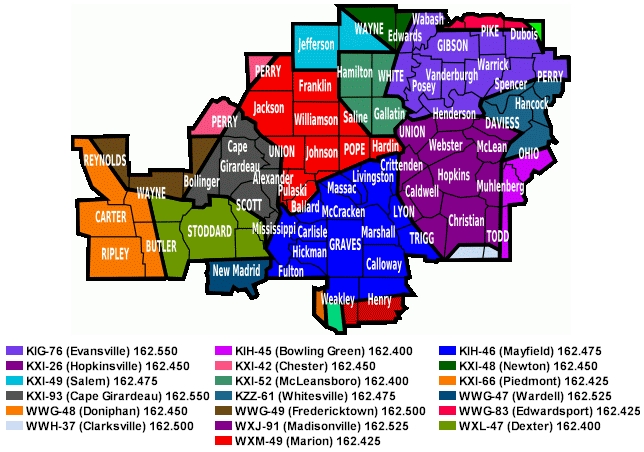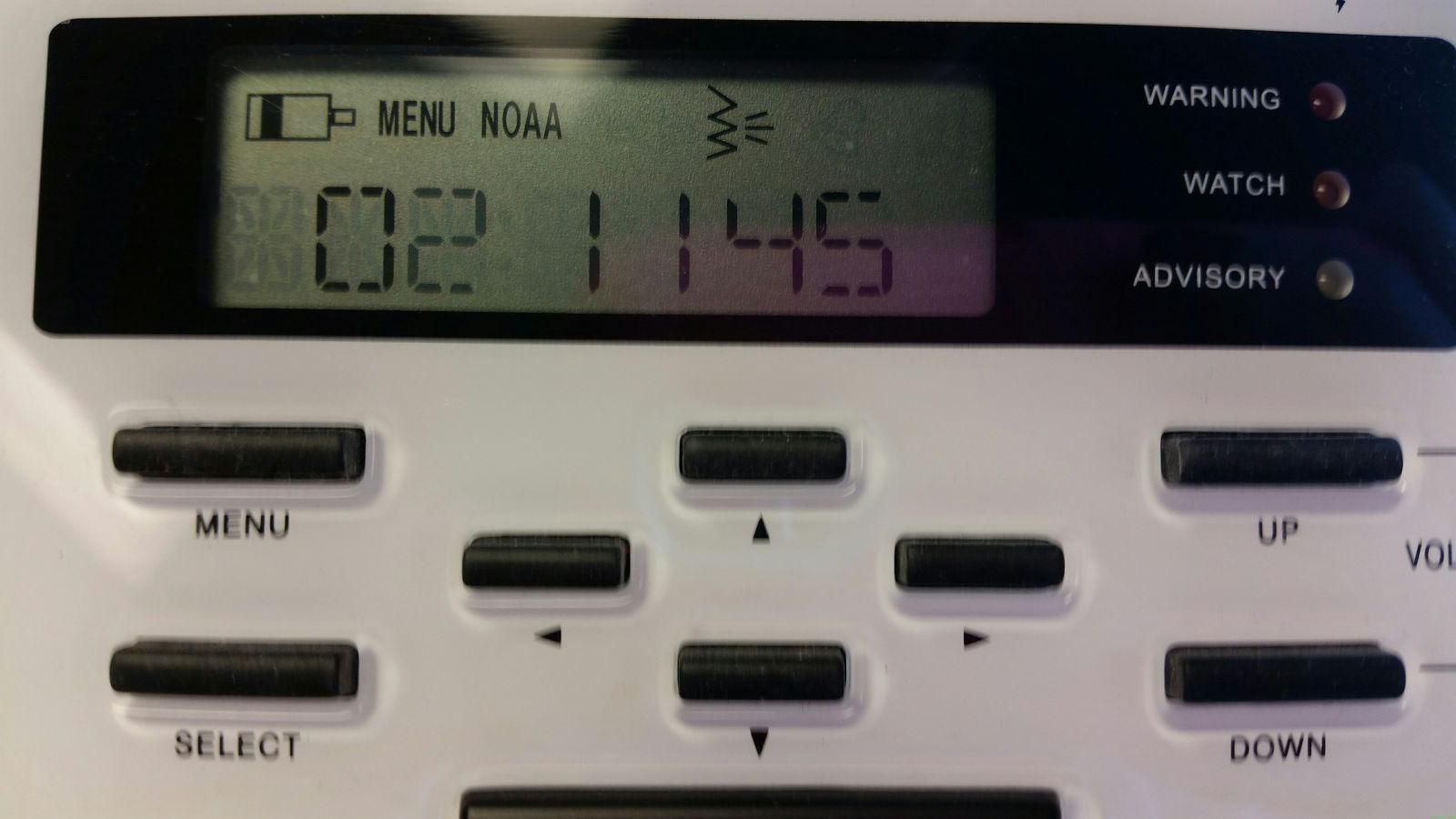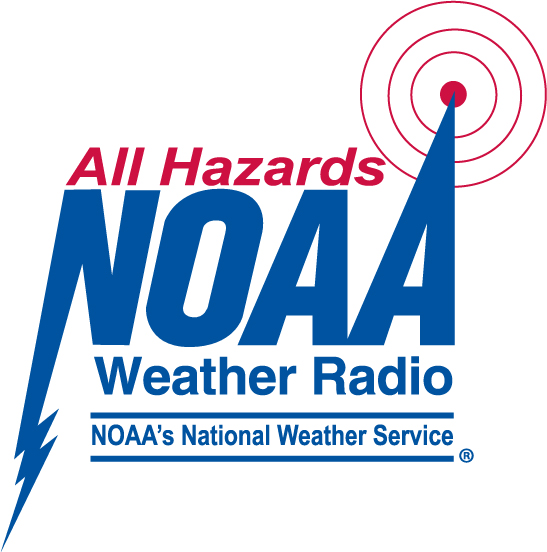
WHAT IS NOAA WEATHER RADIO?:
- NOAA Weather Radio (NWR) is a nationwide network of radio stations broadcasting continuous weather information 24/7, direct from a nearby National Weather Service office. NOAA Weather Radio serves as an alerting device for any life-threatening emergency, whether it's weather-related or not. NOAA Weather Radio, also called NOAA All-Hazards Radio, broadcasts information on chemical spills, forest fires, and terrorist attacks, in addition to weather hazards. Therefore, it is your single source for comprehensive weather and emergency information.

- The Paducah National Weather Service office now operates a total of eleven NOAA Weather Radio transmitters. The map below indicates the approximate coverage area of each transmitter, along with the frequency and call sign. The color shades in each transmitter area are not intended to depict actual transmitter signal coverage.
- NOAA Weather Radio All Hazards transmitters broadcast on one of seven VHF frequencies from 162.400 MHz to 162.550 MHz. The broadcasts cannot be heard on a simple AM/FM radio receiver. There are many receiver options, ranging from handheld portable units which just pick up Weather Radio broadcasts, to desktop and console models which receive Weather Radio as well as other broadcasts.
- NOAA Weather Radio is a round the clock source of weather reports and information to help you prepare for the day ahead. The regular broadcasts are specially tailored to the weather information needs of the people within the service area of the transmitter. Routine programming is repeated every few minutes and consists of the local forecast, regional weather conditions, river stages and forecasts, climate data and much more. The information is updated as needed. During emergencies, routine broadcasts are interrupted for any watches, warnings and other critical information.


* Note: Click image for a larger view. Also, the above listing is not inclusive for the following transmitters: WWG-47, WWG-49, KXI-42, KXI-49, KXI-48, WWG-83, KIH-45 & WWH-37 For a complete list of counties served by these transmitters, click here.
USING NOAA WEATHER RADIOS WITH S.A.M.E:
- NOAA Weather Radios equipped with a special alarm tone feature can sound an alert and give you immediate information about a life threatening situation. During emergencies, NWS forecasters will interrupt normal routine weather radio programming and send out a special tone that activates weather radios in the listening area. NOAA Weather Radios with the SAME (Specific Area Message Encoding) capability use digital coding to automatically activate (turn on) and alert for specific weather or emergency conditions in specific areas. You can program NOAA Weather Radios with the SAME technology for the county or counties you desire. Some models even allow you to enable or disable certain alert types (Amber alerts, etc).
- NOAA Weather Radios without the SAME capability, will alert for emergencies for anywhere within the coverage area of the actual NWR transmitter, which is usually several counties. As an example, if you lived in Paducah KY, you would have your NOAA Weather Radio set to listen to the Mayfield KY transmitter (KIH-46). You can see from the map above that the Mayfield transmitter covers a large area (see area in dark blue), about 15 counties. If your weather radio did not have SAME and a tornado warning was issued for Murray KY (Calloway County), which is nowhere near Paducah, your NOAA Weather Radio would still alert since Calloway County is under the umbrella of the Mayfield transmitter. But if you have a SAME receiver and just had McCracken County programmed into your weather radio, the radio would not alarm since the warning was for Calloway County.
- After buying a NOAA Weather Radio with SAME, you must program your county, parish, independent city or marine area into the radio. First, you have to determine which frequency to set your radio to. Use the transmitter list above to choose based on the county you reside in. Then, program in the county or counties of your choosing. Once programmed, your NWR will then alert you only of weather and other emergencies for the county(s) / area(s) you chose. To program your radio with the proper county(s) and marine area(s) of choice, you need to know the 6-digit SAME code number to enter into the weather radio. Follow the directions in your radio's user's manual.
- You can get your SAME number in a few ways:

- Online at the United States and Territories Table.
- By telephone at 1-888-NWR-SAME (1-888-697-7263) for a voice menu.
- Or by looking at the map below which shows SAME codes for all counties in our area and surrounding counties.
.png)
-Click image for a larger view-
- When a NWS office broadcasts a warning, watch or non-weather emergency, it also broadcasts this digital SAME code that may be heard as a very brief static burst, depending on the characteristics of the receiver. This SAME code contains the type of message, county(s) affected, and message expiration time. A programmed NWR SAME receiver will turn on for that message, with the listener hearing the 1050 Hz warning alarm tone as an attention signal, followed by the broadcast message. At the end of the broadcast message, listeners will hear a brief digital end-of-message static burst followed by a resumption of the NWR broadcast cycle.
Frequently Asked Questions:
1) When is the NOAA Weather Radio transmitter tested?
The NOAA Weather Radio alarm is routinely tested each Wednesday between the hours of 10 A.M. and noon, weather permitting. On the first Wednesday of each month, the alarm is also tested between 6 and 7:30 P.M. In the event of severe weather, the test is postponed until the first available good weather day.
2) How do I report a transmitter that is not working?
Visit the Current Outages webpage first to see if the outage has been reported. If you need to report the outage, fill out an Outage Report. If your NWR receiver is not working properly or you need assistance in programming your NWR receiver, please click here for a list of manufacturers for assistance (Adobe PDF format).
3) Where do I buy a NOAA Weather Radio and what features should I look for?
Check with stores that sell electronics. Weather radios come in many sizes and with a variety of functions and costs. To make use of the digital SAME coding technology, more sophisticated weather radios are required. Most NOAA Weather Radios are either battery operated portables or AC powered desktop models with battery backup. There are also many cell phone apps that allow you to listen to the broadcast as well. Visit this webpage for more information.
4) Where do I learn more about the automated voices used for the NOAA Weather Radio broadcasts?
Visit this webpage for more information.
5) Are there NOAA Weather Radio coverage maps available?
Below are coverage maps for each one of our transmitters:
KENTUCKY INDIANA ILLINOIS MISSOURI
6) What can I do if my reception is poor?
Learn about NOAA Weather Radio reception limitations here.
7) What can I hear on the NWS Paducah KY office broadcasts?

8) How can I find the location and frequency of the nearest NOAA Weather Radio transmitter?
Click here See the instructions on the legend.
9) Is there any information for people with special needs?
Visit this webpage for assistance.
10) What does "All Hazard" weather radio mean?
NWR broadcasts warnings and post-event information for all types of hazards: weather (e.g., tornadoes, floods), natural (e.g., earthquakes, forest fires and volcanic activity), technological (e.g., chemical releases, oil spills, nuclear power plant emergencies, etc.), and national emergencies (e.g., terrorist attacks). Working with other Federal agencies and the Federal Communications Commission's (FCC) Emergency Alert System (EAS), NWR is an all-hazards radio network, making it the most comprehensive weather and emergency information available to the public. Life-threatening weather emergency messages are alerted on NWR. Many of those same weather-related emergency messages are also broadcast via the EAS.
For non-weather emergencies, NWS activates the system at the request of local and/or state officials. NWS does not initiate the contact or the message. Local or state officials provide text information about the non-weather hazard directly to the local NWS offices. NWS offices set up agreements to speed the process, since minutes make a difference. In most areas, the local or state Office of Emergency Management or Preparedness, civil defense, police or mayor/commissioner sets up linkages to send messages on systems such as the EAS and NWR.






.png)

